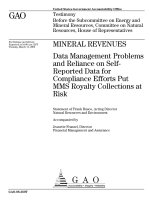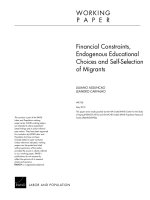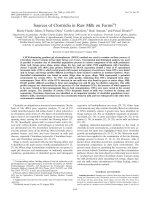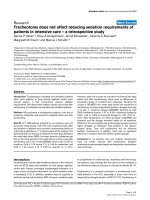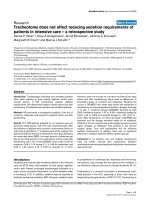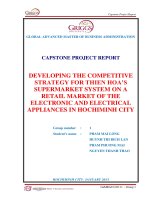Effecting of educational level on self medication decition of patients in hochiminh city
Bạn đang xem bản rút gọn của tài liệu. Xem và tải ngay bản đầy đủ của tài liệu tại đây (1.79 MB, 94 trang )
NATIONAL UNIVERSITY OF HCM
INSTITUTE OF SOCIAL STUDIES
UNIVERSITY OF ECONOMICS
THE HAGUE
THE NETHERLANDS
VIETNAM
VIETNAM-THE NETHERLANDS PROJECT ON DEVELOPMENT ECONOMICS
EFFECT OF EDUCATIONAL LEVEL ON
SELF-MEDICATION DECISION OF PATIENTS
IN HOCHIMINH CITY
A thesis submitted in partial fulfillment of the requirements for the degree of
MASTER OF ARTS IN DEVELOPMENT ECONOMICS
By
PHAM QUANG ANH THU
BO.GIAo ovc ~At:
TI:!_li VIiJ~'N
5
Academic Supervisor:
DR. NGUYEN VAN NGAI
HO CHI MINH CITY, AUGUST 2007
:., 0 TAo-.
TRUdNG fJH KINH .,.:: T~
6~Zr;
'c · 1~.HCM
.
ACKNOWLEDGEMENTS
The author would like to express sincere thanks and special thanks to the academic
supervisor Dr. Nguyen Van Ngai for his assistance and suggestion during the
writing of this thesis.
I am grateful to Dr. Nguyen Trong Hoai, Dr. Nguyen Hoang Bao and Dr. Arjun
Singh Beddi for their useful comments on thesis proposal and thesis drafts which
are helpful to the author in doing the thesis.
I also express my special thanks to M.A Truong Dang Thuy, without his regular
and precious advices the author could not complete the research.
Great appreciation is expressed to my classmates, Quyen and Vy, for their honest
friendship, enthusiastic support and sharing during studying at the Vietnam Netherlands Program for M.A in Development Economics.
Sincere thanks go to my family for their spiritual encouragement and material
support which helped me overcome all difficulties during pursuing my M.A
program.
Last but not least, many thanks are given to the households who allowed the author
to interview them.
11
CERTIFICATION
I certify that the substance of this thesis has not already been submitted for
any degree and is not being current submitted for any other degree.
I certify that to the best of my knowledge any help received in preparing
this thesis, and all sources used, have been acknowledged in this thesis.
PHAM QUANG ANH THU
Date: 01 August, 2007
111
ABSTRACT
Self-medication is a common practice in many developing countries. In Vietnam,
self-medication has grown in recent years due to the increasing availability of drug
vendors and pharmacy shops throughout the country. Beside the convenience, time
and cost saving, self-medication is associated with risks such as misdiagnosis, use
of irrational drug dosage that lead to the harmful consequences not only for patient
himself but also for community as a whole. Investigating the determinants of selfmedication practice of individuals facing illness is helpful for the health policy
makers who are interested in improving the appropriate access of self-medication
in public.
This study focuses on examining the impact of educational level on self-medication
practice in Ho Chi Minh city, the national center of educational and health care of
the country. The descriptive statistics and econometric analyzes have been applied
to answer the question whether the adult individuals with a higher education are
more likely to be self-medicated. The thesis has been employed the theory of
consumer choice as the foundation theory, the Andersen's behaviour model, and
two empirical studies to construct a health-seeking model which describes the way
individuals make choices regarding health care utilization to get the highest level
of utility.
The findings based on the survey conducted by the author in Ho Chi Minh city
show that the more educated individual is, the more self-medication he or she has
in treating minor illness.
iv
TABLE OF CONTENTS
CHAPTER 1: INTRODUCTION ................................................................................................................ 1
1.1.
1.2.
1.3.
1.4.
PROBLEM STATMENT .................................................................................................................... 1
RESEARCH OBJECTIVE, RESEARCH QUESTION & RESEARCH HYPOTHESIS .................... 3
RESEARCH METHODOLOGY ........................................................................................................ 4
THE ORGANIZATION OF THE THESIS ....................................................................................... 5
CHAPTER 2: LITERATURE REVIEW .................................................................................................... 6
2.1. SOME DEFINITIONS ........................................................................................................................ 6
2.1.1 Self-medication ............................................................................................................................. 6
2.1.2 Professional health care provider ................................................................................................. 7
2.1.3 Types of illnesses .......................................................................................................................... 7
2.2. THEORETICAL FRAMWORK ................................................................................................................... 8
2.2.1. Theory of consumer behaviour and the demand for health care services .................................... 8
2.2.2. Grossman's theory ofhuman capital and the demand for health care...................... :................ l2
2.2.3. Andersen's behaviour model and access to medical care........................................................... 15
2.3. EMPIRICAL STUDIES .............................................................................................................. .............. 17
2.3.1. Chang and Trivedi (2003) .......................................................................................................... 18
2.3.2 Arjun S.Bedi eta!. (2003) ........................................................................................................... 19
2.4. MODEL SPECIFICATION ....................................................................................................................... 21
2.4.1. Empirical mode/......................................................................................................................... 23
2.4.2 Transforming theoretical framework into variables................................................................... 26
2.4.2.1 Dependent variable ............................................................................................................ 27
2.. 4.2.2 Independent variables ....................................................................................................... 27
2.5. CONCLUSION ...................................................................................................................................... 32
CHAPTER 3: VIETNAMESE HEALTH CARE AND DRUG UTILAZATION ................................. 34
3 .1. HEALTH CARE UTILIZATION IN VIETNAM ............................................................................................ 34
3.1.1 Trends in health care seeking behaviour ofindividuals................................. ;...................... 34
3.1.2 The Cost of Health Services .................................................................................................. 35
3.1.3 Self-medication and reasons ................................................................................................ 38
3.2. DRUG UTILAZATION & SOURCE OF DRUGS FOR SELF-MEDICATION IN VIETNAM ................................ .40
3.2.1 National drugpolicy ............................................................................................................. 42
3.2.2 Antibiotic resistance.............................................................................................................. 43
3.3. CONCLUSION ...................................................................................................................................... 44
CHAPTER 4: SELF-MEDICATION BEHAVIOUR OF PATIENTS IN HO CHI MINH CITY ....... 46
4.1. OVERVIEW OF HO CHI MINH CITY- THE NATIONAL CENTER OF EDUCATION & HEALTH CARE ............. 46
4.2. DATACOLLECTINGMETHOD ............................................................................................................... 48
4.3. DESCRIPTIVE STATISTICS ...................•............................................................................................ , ... 50
4. 3.1 Individual characteristics .................................................................................................... 51
4.3.2 Price and attributes ofhealth care providers ...................................................................... 55
4.3.3 Knowledge of drug safety ofrespondents ............................................................................ 57
4.4. ECONOMETRIC ANAL YSES ................................................................................................................... 60
4. 4.1 Methods of interpretation. .................................................................................................... 60
4. 4. 2 Explanations ofregression results ....................................................................................... 62
CHAPTER 5: CONCLUSIONS AND RECOMMEND ATIONS ............................................................ 66
5.1.
5.2.
CONCLUSIONS ..................................................................................................................................... 66
RECOMMENDATIONS ........................•.................................................................................................. 68
REFERENCES: ........................................................................................................................................... 71
APPENDICES: ............................................................................................................................................ 78
APPENDIX 1: ............................................................................................................................................. 78
APPENDIX 2: ............................................................................................................................................. 86
APPENDIX 3: ............................................................................................................................................. 87
v
LIST OF FIGURES
FIGURE 2.1: Available health consumption bundleJfor individuals with different health status •••....•..•.•.•• 10
FIGURE 2.2: Effect of income on provider choice ..••••••••••••.•••••••••••..•••••••••••••••..•..•••••••••••.••••••••••...•••••.•••••• 11
FIGURE 2.3: Effect ofprice on provider choice ••.•.•.•.•••••••••••.•••••••••••••..•••••••••••..•..•.•••••••.•.•••••••••••.•.••••.•••••• 11
FIGURE 2.4: Andersen's Behavioural Model •.•.•.••••••••......•••••••••.•.•.•.••••••••••.••••••••••••.•..•••••••....•.•••••••••••..•.• 16
FIGURE 3.1: Selected reason for self-medication by age group •.•.••••••••••••••••••••••••••••.•••••••..••••••.•••••.•••.•.••• 38
LIST OF TABLES
TABLE 2.1: List ofvariables and expected signs •.••••••••••••.••.•••••••••••.••••••••••.••••••••••••••.•.•.••••••...••••••••••••.•••.•• 26
TABLE 3.1: Annualized health services contact rates, by provider •••••••••.••.•.•••••••••.••.••••••.•...•••••••••...•.••••••• 34
TABLE 3.2: Distribution oftotal health services contacts across providers in 1998 ••••••••.••••••••..•.••••••••.••.• 35
TABLE 4.1: Description ofvariables •••.•••.••••••••••.....••••••••••...•.•••••••••.•..•••••••••...•••••••••••.•••••••••....••••••••.••.•••••• 51
TABLE 4.2: Demographic Information of Respondents by behaviour group ••••••.•.••••••.••...•••••••••••.•••••••••.•.• 52
TABLE 4.3: Changing in choosing health care providers ofGroup 3 ••••••••..••••••••••..•.••••••••••.•.•••••••••.••.•••••• 54
TABLE 4.4: Total cost oftreatment by behaviour group•..•..•.•....•......•.•.•.•..•...•..•.•..•.......•...•.....••.....•.....•.•.• 55
TABLE 4.5: Total consuming time of treatment by behaviour group ••••••..•••••••••••.•.•••••••••••...•.•••••••.•...•••••••. 56
TABLE 4.6: Knowledge of drug safety by behaviour group •••••.•...•••••••••••••••••••••••.••••••••••••.•.•••••••.....••••••••••. 51
TABLE 4. 7: Knowledge of drug safety by behaviour and educational group •.•••••••••• ,•.••••••••••.••.•••••••••.•••••• 59
vi
ACRONYMS
GSO
General Statistics Office
UN
United Nations
UNDP
United Nations Development Programme
VHI
Vietnam Health Insurance
VHSR
Vietnamese Health Sector Review
VLSS
Vietnam Living Standards Survey
VNHS
Vietnam National Health Survey
VNDP
Vietnamese National Drug Policy
WB
World Bank
WHO
World Health Organization
vii
CHAPTER 1: INTRODUCTION
1.1 PROBLEM STATEMENT
After the economic reforms initiated in 1986 in Vietnam, the role of public
health sector began to deteriorate which accompanied the emergence of
private sector and the expanding of pharmaceutical industry. Between 1986
and 1994 there was a three-fold increase in drug production and a six-fold
increase in per capita drug consumption (Witter, 1996). The rapidly
expanding drug vendors and pharmacy shops throughout the country have
emerged now acting as an important health care provider. Data from
Vietnam Living Standard Survey 1997-1998 (VLSS, 1997-1998) indicates
that the contact rate with the health care system was dominated by the use of
pharmaceuticals. According to the VLSS 2001-2002, self-medication is very
common practice to deal with illness among Vietnamese households - 73
percent of patients reporting use of self-medication to deal with illness and
most people procure medication for self-medication at pharmacists.
The common practice of self-medication has both positive and negative
aspects. In cases of common illness, such as coughs or colds, self-medication
may be rational behaviour in terms of convenient, time saving and cheap if
patients have sufficient knowledge about common non-prescription drugs.
But in cases of more serious disease, requiring the use of antibiotics or
steroids, or in cases of special status such as pregnancy, babies, people with
1
drug allergies, the treatment without consultation of medical professionals
can lead to harmful consequences. In the latter cases, self-medication
accompanied the lack of ability or awareness of the need to read the drug
information lead to a risky of wasting money, status of sickness may be more
serious. The negative sides of self-medication not only affect the individuals
but also the community. The large scale drug resistance in the community of
Vietnam has increased and reached epidemic levels (Sam, 1993). The future
potency of drug for all users is reduced, which has lead to increasing the
amount of treatment failures, and as the result, leading to longer and more
severe illness and demand for more expensive drugs. This result has
increased financial burden on the poor and those without any medical
kn��������������������������������������������������������������������������������������������������������������������������������������������������������������������������������������������������������������������������������������������������������������������������������������������������������������������������������������������������������������������������������������������������������������������������������������������������������������������������������������������������������������������������������������������������������������������������������������������������������������������������������������������������������������������������������������������������������������������������������������������������������������������������������������������������������������������������������������������������������������������������������������������������������������������������������������������������������������������������������������������������������������������������������������������������������������������������������������������������������������������������������������������������������������������������������������������������������������������������������������������������������������������������������������������������������������������������������������������������������������������������������������������������������������������������������������������������������������������������������������������������������������������������������������������������������������������������������������������������������������������������������������������������������������������������������������������������������������������������������������������������������������������������������������������������������������������������������������������������������������������������������������������������������������������������������������������������������������������������������������������������������������������������������������������������������������������������������������������������������������������������������������������������������������������������������������������������������������������������������������������������������������������������������������������������������������������������������������������������������������������������������������������������������������������������������������������������������������������������������������������������������������������������������������������������������������������������������������������������������������������������������������������������������������������������������������������������������������������������������������������������������������������������������������������������������������������������������������������������������������������������������������������������������������������������������������������������������������������������������������������������������������������������������������������������������������������������������������������������������������������������������������������������������������������������������������������������������������������������������������������������������������������������������������������������������������������������������������������������������������������������������������������������������������������������������������������������������������������������������������������������������������������������������������������������������������������������������������������������������������������������������������������������������������������������������������������������������������������������������������������������������������������������������������������������������������������������������������������������������������������������������������������������������������������������������������������������������������������������������������������������������������������������������������������������������������������������������������������������������������������������������������������������������������������������������������������������������������������������������������������������������������������������������������������������������������������������������������������������������������������������������������������������������������������������������������������������������������������������������������������������������������������������������������������������������������������������������������������������������������������������������������������������������������������������������������������������������������������������������������������������������������������������������������������������������������������������������������������������������������������������������������������������������������������������������������������������������������������������������������������������������������������������������������������������������������������������������������������������������������������������������������������������������������������������������������������������������������������������������������������������������������������������������������������������������������������������������������������������������������������������������������������������������������������������������������������������������������������������������������������������������������������������������������������������������������������������������������������������������������������������������������������������������������������������������������������������������������������������������������������������������������������������������������������������������������������������������������������������������������������������������������������������������������������������������������������������������������������������������������������������������������������������������������������������������������������������������������������������������������������������������������������������������������������������������������������������������������������������������������������������������������������������������������������������������������������������������������������������������������������������������������������������������������������������������������������������������������������������������������������������������������������������������������������������������������������������������������������������������������������������������������������������������������������������������������������������������������������������������������������������������������������������������������������������������������������������������������������������������������������������������������������������������������������������������������������������������������������������������������������������������������������������������������������������������������������������������������������������������������������������������������������������������������������������������������������������������������������������������������������������������������������������������������������������������������������������������������������������������������������������������������������������������������������������������������������������������������������������������������������������������������������������������������������������������������������������������������������������������������������������������������������������������������������������������������������������������������������������������������������������������������������������������������������������������������������������������������������������������������������������������������������������������������������������������������������������������������������������������������������������������������������������������������������������������������������������������������������������������������������������������������������������������������������������������������������������������������������������������������������������������������������������������������������������������������������������������������������������������������������������������������������������������������������������������������������������������������������������������������������������������������������������������������������������������������������������������������������������������������������������������������������������������������������������������������������������������������������������������������������������������������������������������������������������������������������������������������������������������������������������������������������������������������������������������������������������������������������������������������������������������������������������������������������������������������������������������������������������������������������������������������������������������������������������������������������������������������������������������������������������������������������������������������������������������������������������������������������������������������������������������������������������������������������������������������������������������������������������������������������������������������������������������������������������������������������������������������������������������������������������������������������������������������������������������������������������������������������������������������������������������������������������������������������������������������������������������������������������������������������������������������������������������������������������������������������������������������������������������������������������������������������������������������������������������������������������������������������������������������������������������������������������������������������������������������������������������������������������������������������������������������������������������������������������������������������������������������������������������������������������������������������������������������������������������������������������������������������������������������������������������������������������������������������������������������������������������������������������������������������������������������������������������������������������������������������������������������������������������������������������������������������������������������������������������������������������������������������������������������������������������������������������������������������������������������������������������������������������������������������������������������������������������������������������������������������������������������������������������������������������������������������������������������������������������������������������������������������������������������������������������������������������������������������������������������������������������������������������������������������������������������������������������������������������������������������������������������������������������������������������������������������������������������������������������������������������������������������������������������������������������������������������������������������������������������������������������������������������������������������������������������������������������������������������������������������������������������������������������������������������������������������������������������������������������������������������������������������������������������������������������������������������������������������������������������������������������������������������������������������������������������������������������������������������������������������������������������������������������������������������������������������������������������������������������������������������������������������������������������������������������������������������������������������������������������������������������������������������������������������������������������������������������������������������������������������������������������������������������������������������������������������������������������������������������������������������������������������������������������������������������������������������������������������������������������������������������������������������������������������������������������������������������������������������������������������������������������������������������������������������������������������������������������������������������������������������������������������������������������������������������������������������������������������������������������������������������������������������������������������������������������������������������������������������������������������������������������������������������������������������������������������������������������������������������������������������������������������������������������������������������������������������������������������������������������������������������������������������������������������������������������������������������������������������������������������������������������������������������������������������������������������������������������������������������������������������������������������������������������������������������������������������������������������������������������������������������������������������������������������������������������������������������������������������������������������������������������������������������������������������������������������������������������������������������������������������������������������������������������������������������������������������������������������������������������������������������������������������������������������������������������������������������������������������������������������������������������������������������������������������������������������������������������������������������������������������������������������������������������������������������������������������������������������������������������������������������������������������������������������������������������������������������������������������������������������������������������������������������������������������������������������������������������������������������������������������������������������������������������������������������������������������������������������������������������������������������������������������������������������������������������������������������������������������������������������������������������������������������������������������������������������������������������������������������������������������������������������������������������������������������������������������������������������������������������������������������������������������������������������������������������������������������������������������������������������������������������������������������������������������������������������������������������������������������������������������������������������������������������������������������������������������������������������������������������������������������������������������������������������������������������������������������������������������������������������������������������������������������������������������������������������������������������������������������������������������������������������������������������������������������������������������������������������������������������������������������������������������������������������������������������������������������������������������������������������������������������������������������������������������������������������������������������������������������������������������������������������������������������������������������������������������������������������������������������������������������������������������������������������������������������������������������������������������������������������������������������������������������������������������������������������������������������������������������������������������������������������������������������������������������������������������������������������������������������������������������������������������������������������������������������������������������������������������������������������������������������������������������������������������������������������������������������������������������������������������������������������������������������������������������������������������������������������������������������������������������������������������������������������������������������������������������������������������������������������������������������������������������������������������������������������������������������������������������������������������������������������������������������������������������������������������������������������������������������������������������������������������������������������������������������������������������������������������������������������������������������������������������������������������������������������������������������������������������������������������������������������������������������������������������������������������������������������������������������������������������������������������������������������������������������������������������������������������������������������������������������������������������������������������������������������������������������������������������������������������������������������������������������������������������������������������������������������������������������������������������������������������������������������������������������������������������������������������������������������������������������������������������������������������������������������������������������������������������������������������������������������������������������������������������������������������������������������������������������������������������������������������������������������������������������������������������������������������������������������������������������������������������������������������������������������������������������������������������������������������������������������������������������������������������������������������������������������������������������������������������������������������������������������������������������������������������������������������������������������������������������������������������������������������������������������������������������������������������������������������������������������������������������������������������������������������������������������������������������������������������������������������������������������������������������������������������������������������������������������������������������������������������������������������������������������������������������������������������������������������������������������������������������������������������������������������������������������������������������������������������������������������������������������������������������������������������������������������������������������������������������������������������������������������������������������������������������������������������������������������������������������������������������������������������������������������������������������������������������������������������������������������������������������������������������������������������������������������������������������������������������������������������������������������������������������������������������������������������������������������������������������������������������������������������������������������������������������������������������������������������������������������������������������������������������������������������������������������������������������������������������������������������������������������������������������������������������������������������������������������������������������������������������������������������������������������������������������������������������������������������������������������������������������������������������������������������������������������������������������������������������������������������������������������������������������������������������������������������������������������������������������������������������������������������������������������������������������������������������������������������������������������������������������������������������������������������������������������������������������������������������������������������������������������������������������������������������������������������������������������������������������������������������������������������������������������������������������������������������������������������������������������������������������������������������������������������������������������������������������������������������������������������������������������������������������������������������������������������������������������������������������������������������������������������������������������������������������������������������������������������������������������������������������������������������������������������������������������������������������������������������������������������������������������������������������������������������������������������������������������������������������������������������������������������������������������������������������������������������������������������������������������������������������������������������������������������������������������������������������������������������������������������������������������������������������������������������������������������������������������������������������������������������������������������������������������������������������������������������������������������������������������������������������������������������������������������������������������������������������������������������������������������������������������������������������������������������������������������������������������������������������������������������������������������������������������������������������������������������������������������������������������������������������������������������������������������������������������������������������������������������������������������������������������������������������������������������������������������������������������������������������������������������������������������������������������������������������������������������������������������������������������������������������������������������������������������������������������������������������������������������������������������������������������������������������������������������������������������������������������������������������������������������������������������������������������������������������������������������������������������������������������������������������������������������������������������������������������������������������������������������������������������������������������������������������������������������������������������������������������������������������������������������������������������������������������������������������������������������������������������������������������������������������������������������������������������������������������������������������������������������������������������������������������������������������������������������������������������������������������������������������������������������������������������������������������������������������������������������������������������������������������������������������������������������������������������������������������������������������������������������������������������������������������������������������������������������������������������������������������������������������������������������������������������������������������������������������������������������������������������������������������������������������������������������������������������������������������������������������������������������������������������������������������������������������������������������������������������������������������������������������������������������������������������������������������������������������������������������������������������������������������������������������������������������������������������������������������������������������������������������������������������������������������������������������������������������������������������������������������������������������������������������������������������������������������������������������������������������������������������������������������������������������������������������������������������������������������������������������������������������������������������������������������������������������������������������������������������������������������������������������������������������������������������������������������������������������������������������������������������������������������������������������������������������������������������������������������������������������������������������������������������������������������������������������������������������������������������������������������������������������������������������������������������������������������������������������������������������������������������������������������������������������������������������������������������������������������������������������������������������������������������������������������������������������������������������������������������������������������������������������������������������������������������������������������������������������������������������������������������������������������������������������������������������������������������������������������������������������������������������������������������������������������������������������������������������������������������������������������������������������������������������������������������������������������������������������������������������������������������������������������������������������������������������������������������������������������������������������������������������������������������������������������������������������������������������������������������������������������������������������������������������������������������������������������������������������������������������������������������������������������������������������������������������������������������������������������������������������������������������������������������������������������������������������������������������������������������������������������������������������������������������������������������������������������������������������������������������������������������������������������������������������������������������������������������������������������������������������������������������������������������������������������������������������������������������������������������������������������������������������������������������������������������������������������������������������������������������������������������������������������������������������������������������������������������������������������������������������������������������������������������������������������������������������������������������������������������������������������������������������������������������������������������������������������������������������������������������������������������������������������������������������������������������������������������������������������������������������������������������������������������������������������������������������������������������������������������������������������������������������������������������������������������������������������������������������������������������������������������������������������������������������������������������������������������������������������������������������������������������������������������������������������������������������������������������������������������������������������������������������������������������������������������������������������������������������������������������������������������������������������������������������������������������������������������������������������������������������������������������������������������������������������������������������������������������������������������������������������������������������������������������������������������������������������������������������������������������������������������������������������������������������������������������������������������������������������������������������������������������������������������������������������������������������������������������������������������������������������������������������������������������������������������������������������������������������������������������������������������������������������������������������������������������������������������������������������������������������������������������������������������������������������������������������������������������������������������������������������������������������������������������������������������������������������������������������������������������������������������������������������������������������������������������������������������������������������������������������������������������������������������������������������������������������������������������������������������������������������������������������������������������������������������������������������������������������������������������������������������������������������������������������������������������������������������������������������������������������������������������������������������������������������������������������������������������������������������������������������������������������������������������������������������������������������������������������������������������������������������������������������������������������������������������������������������������������������������������������������������������������������������������������������������������������������������������������������������������������������������������������������������������������������������������������������������������������������������������������������������������������������������������������������������������������������������������������������������������������������������������������������������������������������������������������������������������������������������������������������������������������������������������������������������������������������������������������������������������������������������������������������������������������������������������������������������������������������������������������������������������������������������������������������������������������������������������������������������������������������������������������������������������������������������������������������������������������������������������������������������������������������������������������������������������������������������������������������������������������������������������������������������������������������������������������������������������������������������������������������������������������������������������������������������������������������������������������������������������������������������������������������������������������������������������������������������������������������������������������������������������������������������������������������������������������������������������������������������������������������������������������������������������������������������������������������������������������������������������������������������������������������������������������������������������������������������������������������������������������������������������������������������������������������������������������������������������������������������������������������������������������������������������������������������������������������������������������������������������������������������������������������������������������������������������������������������������������������������������������������������������������������������������������������������������������������������������������������������������������������������������������������������������������������������������������������������������������������������������������������������������������������������������������������������������������������������������������������������������������������������������������������������������������������������������������������������������������������������������������������������������������������������������������������������������������������������������������������������������������������������������������������������������������������������������������������������������������������������������������������������������������������������������������������������������������������������������������������������������������������������������������������������������������������������������������������������������������������������������������������������������������������������������������������������������������������������������������������������������������������������������������������������������������������������������������������������������������������������������������������������������������������������������������������������������������������������������������������������������������������������������������������������������������������������������������������������������������������������������������������������������������������������������������������������������������������������������������������������������������������������������������������������������������������������������������������������������������������������������������������������������������������������������������������������������������������������������������������������������������������������������������������������������������������������������������������������������������������������������������������������������������������������������������������������������������������������������������������������������������������������������������������������������������������������������������������������������������������������������������������������������������������������������������������������������������������������������������������������������������������������������������������������������������������������������������������������������������������������������������������������������������������������������������������������������������������������������������������������������������������������������������������������������������������������������������������������������������������������������������������������������������������������������������������������������������������������������������������������������������������������������������������������������������������������������������������������������������������������������������������������������������������������������������������������������������������������������������������������������������������������������������������������������������������������������������������������������������������������������������������������������������������������������������������������������������������������������������������������������������������������������������������������������������������������������������������������������������������������������������������������������������������������������������������������������������������������������������������������������������������������������������������������������������������������������������������������������������������������������������������������������������������������������������������������������������������������������������������������������������������������������������������������������������������������������������������������������������������������������������������������������������������������������������������������������������������������������������������������������������������������������������������������������������������������������������������������������������������������������������������������������������������������������������������������������������������������������������������������������������������������������������������������������������������������������������������������������������������������������������������������������������������������������������������������������������������������������������������������������������������������������������������������������������������������������������������������������������������������������������������������������������������������������������������������������������������������������������������������������������������������������������������������������������������������������������������������������������������������������������������������������������������������������������������������������������������������������������������������������������������������������������������������������������������������������������������������������������������������������������������������������������������������������������������������������������������������������������������������������������������������������������������������������������������������������������������������������������������������������������������������������������������������������������������������������������������������������������������������������������������������������������������������������������������������������������������������������������������������������������������������������������������������������������������������������������������������������������������������������������������������������������������������������������������������������������������������������������������������������������������������������������������������������������������������������������������������������������������������������������������������������������������������������������������������������������������������������������������������������������������������������������������������������������������������������������������������������������������������������������������������������������������������������������������������������������������������������������������������������������������������������������������������������������������������������������������������������������������������������������������������������������������������������������������������������������������������������������������������������������������������������������������������������������������������������������������������������������������������������������������������������������������������������������������������������������������������������������������������������������������������������������������������������������������������������������������������������������������������������������������������������������������������������������������������������������������������������������������������������������������������������������������������������������������������������������������������������������������������������������������������������������������������������������������������������������������������������������������������������������������������������������������������������������������������������������������������������������������������������������������������������������������������������������������������������������������������������������������������������������������������������������������������������������������������������������������������������������������������������������������������������������������������������������������������������������������������������������������������������������������������������������������������������������������������������������������������������������������������������������������������������������������������������������������������������������������������������������������������������������������������������������������������������������������������������������������������������������������������������������������������������������������������������������������������������������������������������������������������������������������������������������������������������������������������������������������������������������������������������������������������������������������������������������������������������������������������������������������������������������������������������������������������������������������������������������������������������������������������������������������������������������������������������������������������������������������������������������������������������������������������������������������������������������������������������������������������������������������������������������������������������������������������������������������������������������������������������������������������������������������������������������������������������������������������������������������������������������������������������������������������������������������������������������������������������������������������������������������������������������������������������������������������������������������������������������������������������������������������������������������������������������������������������������������������������������������������������������������������������������������������������������������������������������������������������������������������������������������������������������������������������������������������������������������������������������������������������������������������������������������������������������������������������������������������������������������������������������������������������������������������������������������������������������������������������������������������������������������������������������������������������������������������������������������������������������������������������������������������������������������������������������������������������������������������������������������������������������������������������������������������������������������������������������������������������������������������������������������������������������������������������������������������������������������������������������������������������������������������������������������������������������������������������������������������������������������������������������������������������������������������������������������������������������������������������������������������������������������������������������������������������������������������������������������������������������������������������������������������������������������������������������������������������������������������������������������������������������������������������������������������������������������������������������������������������������������������������������������������������������������������������������������������������������������������������������������������������������������������������������������������������������������������������������������������������������������������������������������������������������������������������������������������������������������������������������������������������������������������������������������������������������������������������������������������������������������������������������������������������������������������������������������������������������������������������������������������������������������������������������������������������������������������������������������������������������������������������������������������������������������������������������������������������������������������������������������������������������������������������������������������������������������������������������������������������������������������������������������������������������������������������������������������������������������������������������������������������������������������������������������������������������������������������������������������������������������������������������������������������������������������������������������������������������������������������������������������������������������������������������������������������������������������������������������������������������������������������������������������������������������������������������������������������������������������������������������������������������������������������������������������������������������������������������������������������������������������������������������������������������������������������������������������������������������������������������������������������������������������������������������������������������������������������������������������������������������������������������������������������������������������������������������������������������������������������������������������������������������������������������������������������������������������������������������������������������������������������������������������������������������������������������������������������������������������������������������������������������������������������������������������������������������������������������������������������������������������������������������������������������������������������������������������������������������������������������������������������������������������������������������������������������������������������������������������������������������������������������������������������������������������������������������������������������������������������������������������������������������������������������������������������������������������������������������������������������������������������������������������������������������������������������������������������������������������������������������������������������������������������������������������������������������������������������������������������������������������������������������������������������������������������������������������������������������������������������������������������������������������������������������������������������������������������������������������������������������������������������������������������������������������������������������������������������������������������������������������������������������������������������������������������������������������������������������������������������������������������������������������������������������������������������������������������������������������������������������������������������������������������������������������������������������������������������������������������������������������������������������������������������������������������������������������������������������������������������������������������������������������������������������������������������������������������������������������������������������������������������������������������������������������������������������������������������������������������������������������������������������������������������������������������������������������������������������������������������������������������������������������������������������������������������������������������������������������������������������������������������������������������������������������������������������������������������������������������������������������������������������������������������������������������������������������������������������������������������������������������������������������������������������������������������������������������������������������������������������������������������������������������������������������������������������������������������������������������������������������������������������������������������������������������������������������������������������������������������������������������������������������������������������������������������������������������������������������������������������������������������������������������������������������������������������������������������������������������������������������������������������������������������������������������������������������������������������������������������������������������������������������������������������������������������������������������������������������������������������������������������������������������������������������������������������������������������������������������������������������������������������������������������������������������������������������������������������������������������������������������������������������������������������������������������������������������������������������������������������������������������������������������������������������������������������������������������������������������������������������������������������������������������������������������������������������������������������������������������������������������������������������������������������������������������������������������������������������������������������������������������������������������������������������������������������������������������������������������������������������������������������������������������������������������������������������������������������������������������������������������������������������������������������������������������������������������������������������������������������������������������������������������������������������������������������������������������������������������������������������������������������������������������������������������������������������������������������������������������������������������������������������������������������������������������������������������������������������������������������������������������������������������������������������������������������������������������������������������������������������������������������������������������������������������������������������������������������������������������������������������������������������������������������������������������������������������������������������������������������������������������������������������������������������������������������������������������������������������������������������������������������������������������������������������������������������������������������������������������������������������������������������������������������������������������������������������������������������������������������������������������������������������������������������������������������������������������������������������������������������������������������������������������������������������������������������������������������������������������������������������������������������������������������������������������������������������������������������������������������������������������������������������������������������������������������������������������������������������������������������������������������������������������������������������������������������������������������������������������������������������������������������������������������������������������������������������������������������������������������������������������������������������������������������������������������������������������������������������������������������������������������������������������������������������������������������������������������������������������������������������������������������������������������������������������������������������������������������������������������������������������������������������������������������������������������������������������������������������������������������������������������������������������������������������������������������������������������������������������������������������������������������������������������������������������������������������������������������������������������������������������������������������������������������������������������������������������������������������������������������������������������������������������������������������������������������������������������������������������������������������������������������������������������������������������������������������������������������������������������������������������������������������������������������������������������������������������������������������������������������������������������������������������������������������������������������������������������������������������������������������������������������������������������������������������������������������������������������������������������������������������������������������������������������������������������������������������������������������������������������������������������������������������������������������������������������������������������������������������������������������������������������������������������������������������������������������������������������������������������������������������������������������������������������������������������������������������������������������������������������������������������������������������������������������������������������������������������������������������������������������������������������������������������������������������������������������������������������������������������������������������������������������������������������������������������������������������������������������������������������������������������������������������������������������������������������������������������������������������������������������������������������������������������������������������������������������������������������������������������������������������������������������������������������������������������������������������������������������������������������������������������������������������������������������������������������������������������������������������������������������������������������������������������������������������������������������������������������������������������������������������������������������������������������������������������������������������������������������������������������������������������������������������������������������������������������������������������������������������������������������������������������������������������������������������������������������������������������������������������������������������������������������������������������������������������������������������������������������������������������������������������������������������������������������������������������������������������������������������������������������������������������������������������������������������������������������������������������������������������������������������������������������������������������������������������������������������������������������������������������������������������������������������������������������������������������������������������������������������������������������������������������������������������������������������������������������������������������������������������������������������������������������������������������������������������������������������������������������������������������������������������������������������������������������������������������������������������������������������������������������������������������������������������������������������������������������������������������������������������������������������������������������������������������������������������������������������������������������������������������������������������������������������������������������������������������������������������������������������������������������������������������������������������������������������������������������������������������������������������������������������������������������������������������������������������������������������������������������������������������������������������������������������������������������������������������������������������������������������������������������������������������������������������������������������������������������������������������������������������������������������������������������������������������������������������������������������������������������������������������������������������������������������������������������������������������������������������������������������������������������������������������������������������������������������������������������������������������������������������������������������������������������������������������������������������������������������������������������������������������������������������������������������������������������������������������������������������������������������������������������������������������������������������������������������������������������������������������������������������������������������������������������������������������������������������������������������������������������������������������������������������������������������������������������������������������������������������������������������������������������������������������������������������������������������������������������������������������������������������������������������������������������������������������������������������������������������������������������������������������������������������������������������������������������������������������������������������������������������������������������������������������������������������������������������������������������������������������������������������������������������������������������������������������������������������������������������������������������������������������������������������������������������������������������������������������������������������������������������������������������������������������������������������������������������������������������������������������������������������������������������������������������������������������������������������������������������������������������������������������������������������������������������������������������������������������������������������������������������������������������������������������������������������������������������������������������������������������������������������������������������������������������������������������������������������������������������������������������������������������������������������������������������������������������������������������������������������������������������������������������������������������������������������������������������������������������������������������������������������������������������������������������������������������������������������������������������������������������������������������������������������������������������������������������������������������������������������������������������������������������������������������������������������������������������������������������������������������������������������������������������������������������������������������������������������������������������������������������������������������������������������������������������������������������������������������������������������������������������������������������������������������������������������������������������������������������������������������������������������������������������������������������������������������������������������������������������������������������������������������������������������������������������������������������������������������������������������������������������������������������������������������������������������������������������������������������������������������������������������������������������������������������������������������������������������������������������������������������������������������������������������������������������������������������������������������������������������������������������������������������������������������������������������������������������������������������������������������������������������������������������������������������������������������������������������������������������������������������������������������������������������������������������������������������������������������������������������������������������������������������������������������������������������������������������������������������������������������������������������������������������������������������������������������������������������������������������������������������������������������������������������������������������������������������������������������������������������������������������������������������������������������������������������������������������������������������������������������������������������������������������������������������������������������������������������������������������������������������������������������������������������������������������������������������������������������������������������������������������������������������������������������������������������������������������������������������������������������������������������������������������������������������������������������������������������������������������������������������������������������������������������������������������������������������������������������������������������������������������������������������������������������������������������������������������������������������������������������������������������������������������������������������������������������������������������������������������������������������������������������������������������������������������������������������������������������������������������������������������������������������������������������������������������������������������������������������������������������������������������������������������������������������������������������������������������������������������������������������������������������������������������������������������������������������������������������������������������������������������������������������������������������������������������������������������������������������������������������������������������������������������������������������������������������������������������������������������������������������������������������������������������������������������������������������������������������������������������������������������������������������������������������������������������������������������������������������������������������������������������������������������������������������������������������������������������������������������������������������������������������������������������������������������������������������������������������������������������������������������������������������������������������������������������������������������������������������������������������������������������������������������������������������������������������������������������������������������������������������������������������������������������������������������������������������������������������������������������������������������������������������������������������������������������������������������������������������������������������������������������������������������������������������������������������������������������������������������������������������������������������������������������������������������������������������������������������������������������������������������������������������������������������������������������������������������������������������������������������������������������������������������������������������������������������������������������������������������������������������������������������������������������������������������������������������������������������������������������������������������������������������������������������������������������������������������������������������������������������������������������������������������������������������������������������������������������������������������������������������������������������������������������������������������������������������������������������������������������������������������������������������������������������������������������������������������������������������������������������������������������������������������������������������������������������������������������������������������������������������������������������������������������������������������������������������������������������������������������������������������������������������������������������������������������������������������������������������������������������������������������������������������������������������������������������������������������������������������������������������������������������������������������������������������������������������������������������������������������������������������������������������������������������������������������������������������������������������������������������������������������������������������������������������������������������������������������������������������������������������������������������������������������������������������������������������������������������������������������������������������������������������������������������������������������������������������������������������������������������������������������������������������������������������������������������������������������������������������������������������������������������������������������������������������������������������������������������������������������������������������������������������������������������������������������������������������������������������������������������������������������������������������������������������������������������������������������������������������������������������������������������������������������������������������������������������������������������������������������������������������������������������������������������������������������������������������������������������������������������������������������������������������������������������������������������������������������������������������������������������������������������������������������������������������������������������������������������������������������������������������������������������������������������������������������������������������������������������������������������������������������������������������������������������������������������������������������������������������������������������������������������������������������������������������������������������������������������������������������������������������������������������������������������������������������������������������������������������������������������������������������������������������������������������������������������������������������������������������������������������������������������������������������������������������������������������������������������������������������������������������������������������������������������������������������������������������������������������������������������������������������������������������������������������������������������������������������������������������������������������������������������������������������������������������������������������������������������������������������������������������������������������������������������������������������������������������������������������������������������������������������������������������������������������������������������������������������������������������������������������������������������������������������������������������������������������������������������������������������������������������������������������������������������������������������������������������������������������������������������������������������������������������������������������������������������������������������������������������������������������������������������������������������������������������������������������������������������������������������������������������������������������������������������������������������������������������������������������������������������������������������������������������������������������������������������������������������������������������������������������������������������������������������������������������������������������������������������������������������������������������������������������������������������������������������������������������������������������������������������������������������������������������������������������������������������������������������������������������������������������������������������������������������������������������������������������������������������������������������������������������������������������������������������������������������������������������������������������������������������������������������������������������������������������������������������������������������������������������������������������������������������������������������������������������������������������������������������������������������������������������������������������������������������������������������������������������������������������������������������������������������������������������������������������������������������������������������������������������������������������������������������������������������������������������������������������������������������������������������������������������������������������������������������������������������������������������������������������������������������������������������������������������������������������������������������������������������������������������������������������������������������������������������������������������������������������������������������������������������������������������������������������������������������������������������������������������������������������������������������������������������������������������������������������������������������������������������������������������������������������������������������������������������������������������������������������������������������������������������������������������������������������������������������������������������������������������������������������������������������������������������������������������������������������������������������������������������������������������������������������������������������������������������������������������������������������������������������������������������������������������������������������������������������������������������������������������������������������������������������������������������������������������������������������������������������������������������������������������������������������������������������������������������������������������������������������������������������������������������������������������������������������������������������������������������������������������������������������������������������������������������������������������������������������������������������������������������������������������������������������������������������������������������������������������������������������������������������������������������������������������������������������������������������������������������������������������������������������������������������������������������������������������������������������������������������������������������������������������������������������������������������������������������������������������������������������������������������������������������������������������������������������������������������������������������������������������������������������������������������������������������������������������������������������������������������������������������������������������������������������������������������������������������������������������������������������������������������������������������������������������������������������������������������������������������������������������������������������������������������������������������������������������������������������������������������������������������������������������������������������������������������������������������������������������������������������������������������������������������������������������������������������������������������������������������������������������������������������������������������������������������������������������������������������������������������������������������������������������������������������������������������������������������������������������������������������������������������������������������������������������������������������������������������������������������������������������������������������������������������������������������������������������������������������������������������������������������������������������������������������������������������������������������������������������������������������������������������������������������������������������������������������������������������������������������������������������������������������������������������������������������������������������������������������������������������������������������������������������������������������������������������������������������������������������������������������������������������������������������������������������������������������������������������������������������������������������������������������������������������������������������������������������������������������������������������������������������������������������������������������������������������������������������������������������������������������������������������������������������������������������������������������������������������������������������������������������������������������������������������������������������������������������������������������������������������������������������������������������������������������������������������������������������������������������������������������������������������������������������������������������������������������������������������������������������������������������������������������������������������������������������������������������������������������������������������������������������������������������������������������������������������������������������������������������������������������������������������������������������������������������������������������������������������������������������������������������������������������������������������������������������������������������������������������������������������������������������������������������������������������������������������������������������������������������������������������������������������������������������������������������������������������������������������������������������������������������������������������������������������������������������������������������������������������������������������������������������������������������������������������������������������������������������������������������������������������������������������������������������������������������������������������������������������������������������������������������������������������������������������������������������������������������������������������������������������������������������������������������������������������������������������������������������������������������������������������������������������������������������������������������������������������������������������������������������������������������������������������������������������������������������������������������������������������������������������������������������������������������������������������������������������������������������������������������������������������������������������������������������������������������������������������������������������������������������������������������������������������������������������������������������������������������������������������������������������������������������������������������������������������������������������������������������������������������������������������������������������������������������������������������������������������������������������������������������������������������������������������������������������������������������������������������������������������������������������������������������������������������������������������������������������������������������������������������������������������������������������������������������������������������������������������������������������������������������������������������������������������������������������������������������������������������������������������������������������������������������������������������������������������������������������������������������������������������������������������������������������������������������������������������������������������������������������������������������������������������������������������������������������������������������������������������������������������������������������������������������������������������������������������������������������������������������������������������������������������������������������������������������������������������������������������������������������������������������������������������������������������������������������������������������������������������������������������������������������������������������������������������������������������������������������������������������������������������������������������������������������������������������������������������������������������������������������������������������������������������������������������������������������������������������������������������������������������������������������������������������������������������������������������������������������������������������������������������������������������������������������������������������������������������������������������������������������������������������������������������������������������������������������������������������������������������������������������������������������������������������������������������������������������������������������������������������������������������������������������������������������������������������������������������������������������������������������������������������������������������������������������������������������������������������������������������������������������������������������������������������������������������������������������������������������������������������������������������������������������������������������������������������������������������������������������������������������������������������������������������������������������������������������������������������������������������������������������������������������������������������������������������������������������������������������������������������������������������������������������������������������������������������������������������������������������������������������������������������������������������������������������������������������������������������������������������������������������������������������������������������������������������������������������������������������������������������������������������������������������������������������������������������������������������������������������������������������������������������������������������������������������������������������������������������������������������������������������������������������������������������������������������������������������������������������������������������������������������������������������������������������������������������������������������������������������������������������������������������������������������������������������������������������������������������������������������������������������������������������������������������������������������������������������������������������������������������������������������������������������������������������������������������������������������������������������������������������������������������������������������������������������������������������������������������������������������������������������������������������������������������������������������������������������������������������������������������������������������������������������������������������������������������������������������������������������������������������������������������������������������������������������������������������������������������������������������������������������������������������������������������������������������������������������������������������������������������������������������������������������������������������������������������������������������������������������������������������������������������������������������������������������������������������������������������������������������������������������������������������������������������������������������������������������������������������������������������������������������������������������������������������������������������������������������������������������������������������������������������������������������������������������������������������������������������������������������������������������������������������������������������������������������������������������������������������������������������������������������������������������������������������������������������������������������������������������������������������������������������������������������������������������������������������������������������������������������������������������������������������������������������������������������������������������������������������������������������������������������������������������������������������������������������������������������������������������������������������������������������������������������������������������������������������������������������������������������������������������������������������������������������������������������������������������������������������������������������������������������������������������������������������������������������������������������������������������������������������������������������������������������������������������������������������������������������������������������������������������������������������������������������������������������������������������������������������������������������������������������������������������������������������������������������������������������������������������������������������������������������������������������������������������������������������������������������������������������������������������������������������������������������������������������������������������������������������������������������������������������������������������������������������������������������������������������������������������������������������������������������������������������������������������������������������������������������������������������������������������������������������������������������������������������������������������������������������������������������������������������������������������������������������������������������������������������������������������������������������������������������������������������������������������������������������������������������������������������������������������������������������������������������������������������������������������������������������������������������������������������������������������������������������������������������������������������������������������������������������������������������������������������������������������������������������������������������������������������������������������������������������������������������������������������������������������������������������������������������������������������������������������������������������������������������������������������������������������������������������������������������������������������������������������������������������������������������������������������������������������������������������������������������������������������������������������������������������������������������������������������������������������������������������������������������������������������������������������������������������������������������������������������������������������������������������������������������������������������������������������������������������������������������������������������������������������������������������������������������������������������������������������������������������������������������������������������������������������������������������������������������������������������������������������������������������������������������������������������������������������������������������������������������������������������������������������������������������������������������������������������������������������������������������������������������������������������������������������������������������������������������������������������������������������������������������������������������������������������������������������������������������������������������������������������������������������������������������������������������������������������������������������������������������������������������������������������������������������������������������������������������������������������������������������������������������������������������������������������������������������������������������������������������������������������������������������������������������������������������������������������������������������������������������������������������������������������������������������������������������������������������������������������������������������������������������������������������������������������������������������������������������������������������������������������������������������������������������������������������������������������������������������������������������������������������������������������������������������������������������������������������������������������������������������������������������������������������������������������������������������������������������������������������������������������������������������������������������������������������������������������������������������������������������������������������������������������������������������������������������������������������������������������������������������������������������������������������������������������������������������������������������������������������������������������������������������������������������������������������������������������������������������������������������������������������������������������������������������������������������������������������������������������������������������������������������������������������������������������������������������������������������������������������������������������������������������������������������������������������������������������������������������������������������������������������������������������������������������������������������������������������������������������������������������������������������������������������������������������������������������������������������������������������������������������������������������������������������������������������������������������������������������������������������������������������������������������������������������������������������������������������������������������������������������������������������������������������������������������������������������������������������������������������������������������������������������������������������������������������������������������������������������������������������������������������������������������������������������������������������������������������������������������������������������������������������������������������������������������������������������������������������������������������������������������������������������������������������������������������������������������������������������������������������������������������������������������������������������������������������������������������������������������������������������������������������������������������������������������������������������������������������������������������������������������������������������������������������������������������������������������������������������������������������������������������������������������������������������������������������������������������������������������������������������������������������������������������������������������������������������������������������������������������������������������������������������������������������������������������������������������������������������������������������������������������������������������������������������������������������������������������������������������������������������������������������������������������������������������������������������������������������������������������������������������������������������������������������������������������������������������������������������������������������������������������������������������������������������������������������������������������������������������������������������������������������������������������������������������������������������������������������������������������������������������������������������������������������������������������������������������������������������������������������������������������������������������������������������������������������������������������������������������������������������������������������������������������������������������������������������������������������������������������������������������������������������������������������������������������������������������������������������������������������������������������������������������������������������������������������������������������������������������������������������������������������������������������������������������������������������������������������������������������������������������������������������������������������������������������������������������������������������������������������������������������������������������������������������������������������������������������������������������������������������������������������������������������������������������������������������������������������������������������������������������������������������������������������������������������������������������������������������������������������������������������������������������������������������������������������������������������������������������������������������������������������������������������������������������������������������������������������������������������������������������������������������������������������������������������������������������������������������������������������������������������������������������������������������������������������������������������������������������������������������������������������������������������������������������������������������������������������������������������������������������������������������������������������������������������������������������������������������������������������������������������������������������������������������������������������������������������������������������������������������������������������������������������������������������������������������������������������������������������������������������������������������������������������������������������������������������������������������������������������������������������������������������������������������������������������������������������������������������������������������������������������������������������������������������������������������������������������������������������������������������������������������������������������������������������������������������������������������������������������������������������������������������������������������������������������������������������������������������������������������������������������������������������������������������������������������������������������������������������������������������������������������������������������������������������������������������������������������������������������������������������������������������������������������������������������������������������������������������������������������������������������������������������������������������������������������������������������������������������������������������������������������������������������������������������������������������������������������������������������������������������������ave to use up medicine bought follow prescription recommended by doctor.
D Agree
ODon't know/ No idea
ODisagree
5. You have to follow-up examination according to recommendation of doctor.
D Agree
ODon't know/ No idea
ODisagree
According to you, antibiotics should be used in which cases of illnesses?
6. Diarrhoea without fever
D Yes
ONo
ODon't know/ No idea
ONo
ODon't know/ No idea
ONo
ODon't know/ No idea
7. Infection, inflame
D Yes
8. Fever, headache
D Yes
77
9. Stomachache
0
Yes
ONo
ODon't know/ No idea
ONo
ODon't know/ No idea
10. Cough, cold, headache
0
Yes
11. Have you ever treated yourself according to advices from your friends/relationships who
are not doctors/ nurses?
0
Yes
0
No
12. Do you consult your pharmacist about the using of medicine when you have some
diseases?
0
Yes
0
No
o
No
13. Do you have a health insure card?
0
Yes
14. In the past of previous 3 months, do you suffer from any of the below diseases?
(multi-selection is allowed)
1
0
Angina
j0
Gastritis
(Note: Stop interviewing if respondent have had any diseases)
PART II: ILLNESSES AND TREATMENTS
15. For how many days have you suffered from this _ _ _ _ _? ............. days
16. In this period ofbeing _ _ _ _ _,which ways did you choose to treat:
(multi-selection is allowed)
0 a. Buy drug without any prescription from physician/Self-medication
0
b. Go for examination in public health care facilities
0
c. Go for examination in private health care facilities
0
d. Not seek any medical services (go to the other disease)
17. According to you, this
0
a. Very slight
o
b. Slight
0
c. Minority
ts:
78
0
d. Severe
0
e. Very severe
18. In total, how many times did you choose self-medicated and visiting doctor in this
sickness period? _ _ _ _ times
*Note for interviewer: (1) One time ofself-medication is when respondent buy medicine
without any prescription from physician to treat, or buy medicine with an old
prescription; (2) One time of examining and treating medically is going for examination
in any health care facilities, buying and using this prescriptive medicine.
19. In this sickness period, please tell in each time of treatment you chose:
D
First times
Second times
Self-
D
medication
D
Third times
Self-
D
medication
Visiting
D
doctor
Self-
Fourth times
D
medication
Visiting
D
doctor
Visiting
Fifth times
Self-
D
medication
D
doctor
Selfmedication
Visiting
D
doctor
Visiting
doctor
*Note for interviewer (according to information question 19):
If respondent chose visiting doctor only, go to question 20;
If respondent chose visiting doctor after one/some times self-medication,
a.
b.
go
to question 22;
c.
If respondent did not have any visiting doctor, go to question 24.
20. According to you, is the times of being illness longer if you had not have visited
doctor?
0
Yes
0
No
0
Notsure
21. If yes, how many days is it longer? ............ days (Go to Part III)
22. According to you, is it shorter if you had have visited doctor from beginning?
0
Yes
0
No
I
0
Not sure
23. If yes, how many days is it shorter? ................ days (Go to Part III)
24. According to you, is it shorter if you had have visited doctor?
0
Yes
0
No
_l
0
Not sure
25. If yes, how many days is it shorter? ................... days (Go to Part III)
79
PART III:
QUESTIONS ABOUT PHARMACY, HEALTH CARE PROVIDER
*
Note for interviewer: according to information question 19, chose the suitable
following part
Part /Ill
a. Self-medication only
Part Ill2
Part IIL4
X
X
b. Visit doctor only
X
c. Both a. & b.
X
PART 111.1:
Part Ill3
X
X
QUESTIONS ABOUT PHARMACY/DRUG STORE
26. At which pharmacies did you buy medicine? (multi-selection is allowed)
0
a. Near your house
0
b. Near your company
0
c. Most frequent pharmacy
0
d. Others, please specify the reasons: _ _ _ _ _ __
27. In this sickness period, if you had self-medication more than one time, did you buy
medicine at the same pharmacy/drug store?
0
Yes
(Go to question 29)
0
No
28. If you bought medicine at different pharmacies, please tell at which pharmacies you
buy most frequently (chose one option)
0
a. Near your house
0
b. Near your company
0
c. Most frequent pharmacy
0
d. Others, please specify the reasons: _ _ _ _ _ __
29. How many minutes did it take you to buy medicine? _ _ _ _ _ minutes.
* Note for interviewer: The time is two-way time (go to pharmacy,
buying medicine
and coming back).
30. What mean of transport did you use mainly to go to pharmacy?
0
a. On foot
0
b. Bicycle
D c. Motorbike
80
D
d. Others
31. What was the total self-medication cost in this treatment period?
* Note for
interviewer: The total self-medication cost does not include the cost of
buying prescriptive medicine
PART III.2
QUESTIONS ABOUT CLINIC/HOSPITAL
32. At which health care providers did you go for examination and treatment during this
period? (multi-selection is allowed)
D
a. Near your house
D
b. Near your company
D
c. Most frequent clinic/hospital
D
d. Insurance registered clinic/hospital
D
e. Well-reputation clinic/hospital
D
f. Others, please specify the reasons: - - - - - - -
33. Did you use your health insurance card?
D
D No
Yes
34. If you visited doctor more than one time, did you go for examination and treatment
at the same place during this sickness?
D
Yes
(Go to question 36)
D
No
35. If you visited doctor at different health care providers, please tell at which did you
go most frequently (chose one option)
D
a. Near your house
D
b. Near your company
D c. Most frequent clinic/hospital
D
d. Insurance registered clinic/hospital
D
e. Well-reputation clinic/hospital
D
f. Others, please specify the reasons: _ _ _ _ _ __
36. How many minutes did it take you to go to that health care provider? _ _ _ __
minutes.
*Note for interviewer: The time includes time of going to health care provider and
come back
37. How many minutes did it take you to wait at health care provider before seeing
doctor? - - - minutes.
81
* Note for
interviewer: the waiting time excludes the time for testing, and X-ray
checks.
38. How many minutes did the examination take you?
minutes.
39. What mean of transport did you use mainly to go to pharmacy?
0
a. On foot
0
b. Bicycle
0
c. Motorbike
0
d. Others
40. What was the total cost of all consultations m this treatment period?
_ _ _ _VND
41. What was the total cost of buying medicine follow prescription of doctor for all
examinations?
* Note for
VND
interviewer: The total cost of buying medicine without any prescription
from physician to treat, or buy medicine with an old prescription is excluded
42. Did you buy medicine at pharmacy where you took examination?
0
Yes (Stop for this part)
0
No
43. If no, at which pharmacy did you buy medicine? (Chose one suitable option)
0
a. Near your house
0
b. Near your company
0
c. Most frequent pharmacy
0
e. Others
44. Did you bought medicine immediately after leaving health care provider?
0
Yes (Stop for this part)
0
No
45. How many minutes did it take you to buy medicine? _ _ _ _ _ minutes.
*Note for interviewer: The time is two-way time (go to pharmacy, buying medicine
and coming back).
46. What mean of transport did you use mainly to go to pharmacy?
0
a. On foot
0
b. Bicycle
0
c. Motorbike
0
d. Others
82
PART Ill.3:
QUESTIONS ABOUT PHARMACY
4sk this part in case of respondent chose using health care providers for examination and
~reatmn
only.
47. It's supposed that in this time of sickness, you thought that it was not too severe to
visit doctor but self-medication only, at which pharmacy would you buy medicine?
(Chose one sui~able
option)
0
a. Near your house
0
b. Near your company
0
c. Most frequent pharmacy
0
d. Others, please specify the reasons: _ _ _ _ _ __
48. Is it the pharmacy that you mentioned in question 26 or at the health care provider
where you went for examination?
0
Yes
(Go to question 51)
0
No
49. How many minutes did it take you to buy medicine?
* Note for interviewer: The time is two-way time (go to pharmacy,
minutes.
buying medicine
and coming back).
50. What mean of transport did you use mainly to go to pharmacy?
0
a. On foot
0
b. Bicycle
0
c. Motorbike
0
d. Others
51. You think that what the total cost ofbuying medicine would be? ................... VND
PART III.4:
QUESTIONS ABOUT CLINIC/HOSPITAL
Ask this part in case the respondent chose using self-medication only.
52. It's supposed that in this time of sickness, you thought that it was relative severe,
you would go for examination and treatment not self-medication, at which health
care provider would you chose? (Chose one suitable option)
0
a. Near your house
0
b. Near your company
0
c. Most frequent clinic/hospital
0
d. Insurance registered clinic/hospital
0
e. Well-reputation clinic/hospital
83
D
f. Others, please specify the reasons: _ _ _ _ _ __
53. You think that how many minutes it takes you to go to that health care
provider?_ _ _minutes.
* Note for
interviewer: It includes the time of going to health care provider and
come back.
54. What mean of transport did you use mainly to go to pharmacy?
D
a. On foot
D
b. Bicycle
D
c. Motorbike
D
d. Others
55. How many minutes did it take you to wait at health care provider before seeing
doctor? - - - minutes.
* Note for
interviewer: the waiting time excludes the time for testing, and X-ray
checks.
56. How many minutes did the examination take you?
minutes.
57. You think that what the total cost of all consultation would be?
VND
(Excluding the cost of buying medicine following the prescription)
PART IV: GENEARE INTERVIEWEE INFORMATION
Please tell me your:
58. Full name: ......................................................................................... .
59. Age: .................................................................................................. .
60. Sex:
D Male
D
Female
61. Ethnicity:
0
a. Kinh
D b. Chinese
0
c. Others (specify): _ _ _ _ _ __
62. Your current marital status:
D
Single
D Married
D Widowed
D Divorced/Separated
84
63. What is the grade has you finished?
0
Grade .... ./12
0
Vocational
Graduated D
Studying ...... .
0
College:
Graduated D
Studying ...... .
0
University
Graduated D
Studying ...... .
0
Higher than university
0
No formal schooling
64. What are the total years you went to school?
years.
(Note: interviewer compare question 65, excluding years respondents repeated class)
65. For which economic sector do you work for?
0
a. State company/enterprise
0
b. Private company/enterprise
0
c. Joint venture with foreign company
0
d. Self-employed/Free occupation
0
e. Housewife/Househusband
0
f. Unemployment
0
g. Student
66. Please tell me the average monthly of your income bracket is:
D
a. Less than 500.000 VND
0
i. From 4.000.000 to 4.500.000 VND
D
b. From 500.000 to 1.000.000 VND
0
j. From 4.500.000 to 5.000.000 VND
D
c. From 1.000.000 to 1.500.000 VND
0
k. From 5.000.000 to 5.500.000 VND
D
d. From 1.500.000 to 2.000.000 VND
0
1. From 5.500.000 to 6.000.000 VND
D
e. From 2.000.000 to 2.500.000 VND
0
m. From 6.000.000 to 6.500.000 VND
D
f.
From 2.500.000 to 3.000.000 VND
0
n. From 6.500.000 to 7.000.000 VND
D
g. From 3.000.000 to 3.500.000 VND
0
o. From 7.000.000 to 7.500.000 VND
D
h. From 3.500.000 den 4.000.000 VND
0
p. From 7.500.000 to 8.000.000 VND
0
q. More than 8.000.000 VND
67. Do you own this house/apartment or?
0
Rent
o
Own
68. The total area is: ........... m2
85
69. Please tell me how many items you own for each of the following?
Check x if yes
Items
Washing machine
0
Air conditioner
0
Refrigerator
0
Water heater
0
Car
0
70. How much was your electricity bill last month? ...................... VND
APPENDIX2:
Results of question about Knowledge of drug safety
Disagree
Not know/ No idea
Agree
Questions
No.
%
No.
%
No.
%
Question 1
68
57%
13
11%
39
33%
Question 2
37
31%
7
6%
76
63%
Question 3
82
68%
15
13%
23
19%
Question 4
96
80%
7
6%
17
14%
Question 5
100
83%
7
6%
13
11%
Question 6
33
28%
32
27%
55
46%
Question 7
93
78%
10
8%
17
14%
Question 8
61
51%
11
9%
48
40%
Question 9
42
35%
27
23%
51
43%
Question 10
71
59%
14
12%
35
29%
Number ofrespondents=l20
Source: Author's calculationfrom household survey 2007
86
'\
·~
·.t~
APPENDIX 3: Correlation using correlate command in Stata 8
choice
age
edu
gender
married
dayill
choice
1.0000
edu
0.3010
1.0000
age
-0.3300
-0.2327
1.0000
gender
-0.2404
-0.1652
-0.0867
1.0000
married
-0.3406
-0.2488
0.4100
-0.0800
1.0000
dayill
-0.2973
-0.1332
0.2939
0.1262
0.1843
1.0000
difpri
0.2021
-0.0281
-0.1137
0.0047
-0.0460
-0.0354
diftime
0.2670
0.2446
-0.0548
-0.1531
-0.0690
-0.1365
quality
-0.2097
0.0234
0.0828
-0.0605
0.0999
0.0792
ins
-0.3879
-0.1971
0.3510
0.1340
0.3890
0.3345
difpri
diftime
quality
difpri
1.0000
diftime
0.2347
1.0000
quality
-0.0079
-0.1895
1.0000
ins
-0.1128
0.0251
0.0319
ins
1.0000
87
